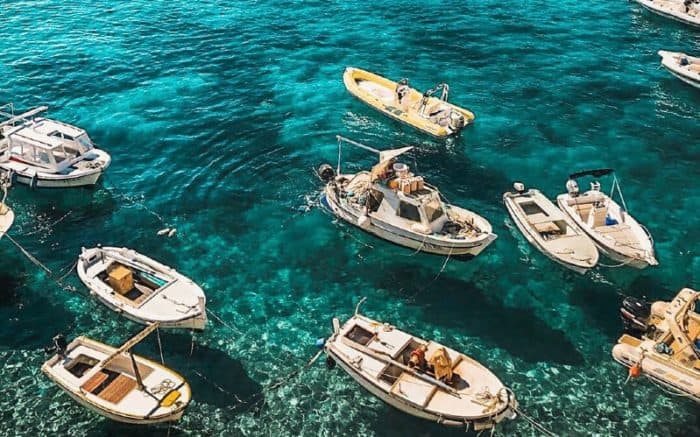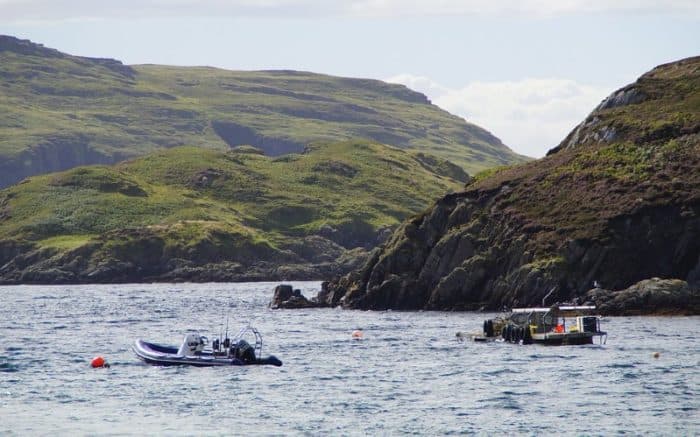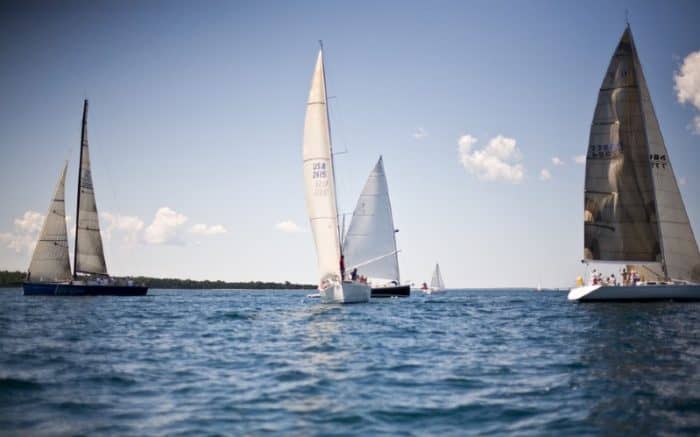When One Boat is Overtaking Another Which Boat Must Give Way?
Unlike other conditions in which boats meet in the water, when one boat is overtaking another boat, the overtaking vessel is always the give way vessel. This will not always be the case based on both how vessels meet, such as head on or crossing paths, and also based on the types of vessels that are interacting. In this case, however, the overtaking will always be the give way regardless of boat type and the boat being overtaken is the stand on vessel. Let’s clarify that a little further as we move on to remove any potential confusion.
Stand on Vessel

A stand on vessel is a vessel that, in a given interaction with another boat on the water, will be maintaining its course and speed. If another boat comes up behind your vessel and moves to overtake, you are now the stand on vessel. One important thing to remember here is that in most cases a power-driven vessel will always give way to a sailing vessel. However, in the case of overtaking, even if you are a power driven vessel, if the boat trying to overtake you is a sailing vessel, you will still be the stand on vessel and the sailing vessel must give way. Stand on vessels are always the vessels being overtaken.
Give Way Vessel

The give way vessel is the vessel that must take action in any given interaction with another vessel. It’s defined as early and substantial action to keep out of the way of the stand on vessel. That means it needs to be done with more than enough time to be out of the way of the stand on vessel before the two cross paths. And it needs to be substantial enough that there is no danger of the two vessels colliding.
As the boat looking to overtake another boat, you are the give way vessel no matter how your boat is powered, be it sailboat or a powered fishing boat, a personal watercraft or an inflatable pontoon. You must take action to pass the other boat while avoiding it at the same time.
If both vessels are under power, the overtaking vessel needs to use a sound signal to indicate their intent to the stand on vessel. This means using a single short horn blast to indicate the intent to pass to starboard or two short horn blasts to indicate the intent to pass to port. The stand on vessel should return these signals to indicate they understand the give way vessel’s intent.
How Do Vessel Power Types Affect Overtaking Other Vessels

Because some newer boaters can get confused by the rules for encountering other boats of different types, we’ll cover it here clearly.
Power Driven Vessel Meets Power Driven Vessel
If you are in a power drive vessel and you are meeting another power driven vessel head on, neither of you qualifies as the stand on vessel and you must both give way. Both of you should pass to the right or starboard sign after making a sound signal indicating to do so. This is where some boaters may get confused because this is when you are meeting head on and NOT when you are overtaking. When overtaking, the vessel being overtaken becomes the stand on, even if it is a powered vessel.
If you are crossing paths, the vessel to port is the give way and the vessel to starboard is the stand on., which is similar to how overtaking works but obviously you’re on different paths.
Power Driven Vessel Meets Sailing Vessel
When a power driven vessel meets a sailing vessel head on, the power driven vessel is always the give way vessel and the sailing vessel is the stand on. This can again be confusing when you compare to overtaking but remember, when overtaking, the vessel being overtaken is always the stand on no matter what the vessel overtaking it is – powered or under sail. Some new boaters mistakenly believe a sailing vessel will always be stand on, but this is not the case when overtaking, not could it be, really.
Sailing Vessel Meets Sailing Vessel
The meeting of sailing vessels can be slightly more confusing for boaters but just remember, again, the overtaking vessel is always the give way vessel. Otherwise, if you’re meeting another sailing vessel in any other situation, the sailing vessel with wind to the port side is the give way vessel. If both boats have wind on the same side, then the upwind vessel is the give way.
Just remember, the overtaking vessel is always the give way vessel.
What Is Early and Substantial Action?

You will see the term “early and substantial” action appear frequently in literature about overtaking other boats. It’s the standard terminology you’ll find in boating regulations and on boating exams detailing how to overtake or otherwise interact with other vessels on the water. It will always refer to the actions that need to be taken by the give way vessel when overtaking, crossing paths or meeting head on. The term is not entirely clear in its definition, however.
You are required to pass another boat at a “safe distance” but if you read most regulations you’ll never find that term defined. This is for a few reasons. First and foremost, the definition of “safe distance” is not set in stone. The distance you need to pass a jon boat when you’re in your own jon boat will likely be different than the distance needed between a super yacht and a sport fishing vessel. Bigger boats need more distance.
Another variable here is that you can only be sure of your own actions. You don’t know if the other boat operator is aware of the rules of the road and how they are going to respond as you overtake. It is your belief and hope they know what they’re doing, but it’s everyone’s responsibility on the water to be safe and do whatever they can to avoid collisions.
Part of that means that you need to be defensive in your actions and never assume another boater is going to help you out of a tight spot. You need to take that responsibility on your own and make sure, by your own actions alone, you overtake safely. For that reason, you will want to give any other boat a wide berth as you pass them, not just for their safety but for your own. More space means you have more time to react if something unexpected happens.
If the other boat has some kind of emergency, or something unexpected happens that you could have never predicted, you want time and space to react accordingly. That could mean yielding, changing course, or slowing down even though it was not your plan. For that reason, I would recommend ensuring you are giving the other boat that you are overtaking at least 100 feet of space on all sides as you overtake. That means the “early” action you take should have you moving out of the way at least 100 feet behind the other boat but ideally much sooner, and then giving them 100 feet of space as you pass them by. If the vessel is a large fishing boat, commercial or military vessel you should be giving at least 100 yards of space between your boat and theirs.
Always Boat Defensively
Overtaking another vessel can be dangerous and you need to be flexible in how you approach this situation. The fact that there are rules for the situation can put people in the mindset that they are “right” and someone else is “wrong” if there is a problem. And that’s very true, an accident could very much be someone else’s fault, but that doesn’t mean you shouldn’t be doing everything in your power to prevent it, even if you are not at fault.
The one rule above all others in a situation like this is to do whatever you can reasonably do to prevent a collision. So even if you believe you should be able to pass at 100 feet to the starboard side, if the other vessel begins to veer into your path, you need to take action to get out of the way. Slow your vessel, change course, whatever needs to happen. You can worry about who messed up later when everyone is still safe and sound and there’s been no accident.
The Bottom Line
When one boat is overtaking another boat on the water, the one that is overtaking automatically becomes the give way vessel. This is true regardless of whether any of the vessels involved are powered by a motor or are moving under sail. That means that the vessel being overtaken should simply maintain course and speed as the stand on vessel. The boat that is overtaking must take early and substantial action to maneuver around the stand on vessel after using sound signals to indicate to the vessel being overtaken of their intentions if they are under power. Once the stand on vessel has acknowledged that they are being overtaken, the give way vessel should pass at a safe distance. Remember to keep out of the way of any vessel not under command, a vessel engaged in fishing, or a vessel restricted in its ability to move.
Categories: Boats











